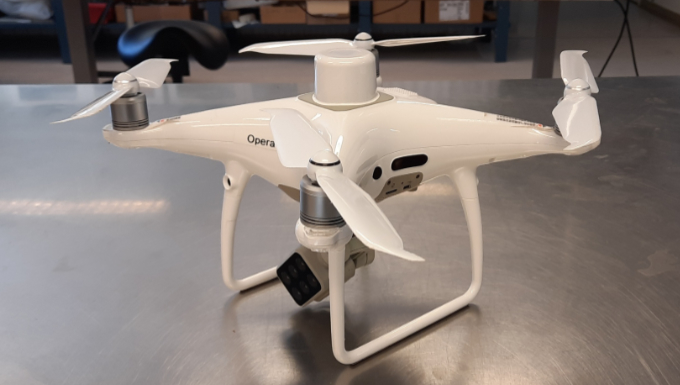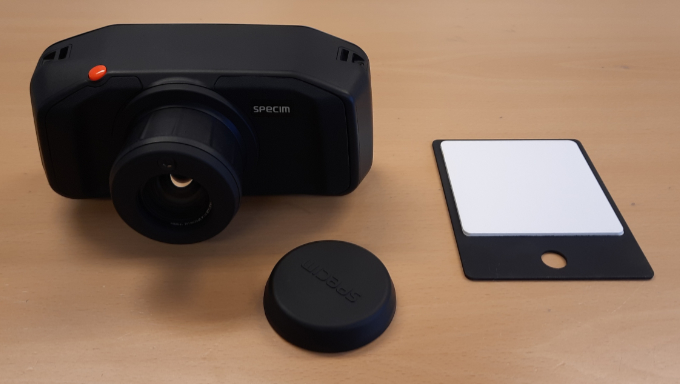Contact
Department of Crop Production Ecology, Crop production science
Department of Crop Production Ecology, Crop production science
Spectral techniques are becoming more available and useful for measuring things in a non-destructive way. At Röbäcksdalen we have different types of spectral techniques available for use. The majority of the equipment is situated in the laboratory at the field research station. In the barn we have GreenFeed units which measure gas production from dairy cows with spectral methods.
Seminar from Öjebyn farmday 2020
Some of our equipment:
Currently we have seven drones at the department in a variety of sizes and with different cameras. Four of these drones are used together with multispectral equipment. The DJI Matrice 210 is used together with the multispectral MAIA camera, this camera has the same nine spectral bands as the sentinel 2 satellite.

The Phantom 4 MS drone from DJI has six seperate cameras. Photo Sanna Bergqvist.
The DJI phantom 4 MS drone has an integrated multispectral camera array with five spectral bands and one RGB camera. DJI phantom 4 and Solo are two drones that are used together with two types of multispectral cameras: Parrot Sequoia and MicaSense RedEdge. These two cameras and drones are part of the SITES monitoring program SITES spectral, but can also be used for other projects. Additionally, there are three smaller drones, outfitted with integrated RGB cameras, DJI Mavic 2 Pro, DJI Mavic mini 2 and DJI Mavic mini.
Due to Röbäcksdalen being situated just 1 km from the runway at Umeå airport, flying with drones is a bit difficult. Therefore, all drone flights have to be carried out by the station's own pilots.
Ultra-sonic sensor is used for plant height estimation, measuring the time for a wave to leave the sensor, hit a vegetation/soil target and get back to the sensor.
These instruments enable to monitor various traits of crops based on their spectral signature. Some commonly retrieved traits include the leaf nitrogen content, leaf water content, which can both be related to stresses, and dry matter yield.
This handheld version of the Yara-N (spectral reflectance from 400 nm to 1000 nm) sensor used by farmers enables to monitor variations of spectral signatures in the visible and near infrared range with a spectral resolution of 10 nm. This tool is particularly convenient to answer to farmers' needs of information on their crops, as the research results obtained with this sensor can be transferred to the farm.
The FieldSpec 4 (wavelength range 350-2500nm) is a highly performant research tool that provides a rich spectral information in the visible, near and short wave infrared ranges with a spectral resolution of 1 nm. It can be used both at the canopy and plant level using a leaf clip and its own light source, with a wide range of applications from discrimination of crops, estimations of nutrition qualities and biomass production.
Röbäcksdalen has 2 masts (4 and 10 meters high) placed in the fields and equipped with the Spectral Reflectance Sensor NDVI (Normalized Difference Vegetation Index), which continuously monitors the NDVI of forage plant canopy, providing indications on their phenological stage and biomass development. These sensors are a part of the SITES spectral monitoring program.
Hyperspectral images combine spatial and spectral information into a 3D matrix called "hypercube". They are becoming increasingly used as they provide a very rich spectral information with the advantages of images, making it possible to create "maps" of traits using appropriate mathematical models.
This camera provides hyperspectral images with a spectral range of 935 to 2457 nm, (near and short wave infrared ranges) and a spectral resolution of app. 12 nm (288 spectral bands). This tool is particularly interesting for research and can be used for a number of applications, from cheese ripening evaluation to the estimation of nutrition quality of silage maize or assessment of the fat content and distribution of a meat sample.

Photo Sanna Bergqvist
Specim IQ is a handheld hyperspectral camera and can be used both indoors and out in the field. The camera has a spectral range between 400-1000 nm (visible and near infrared ranges) with a spectral resolution of 7 nm (204 spectral bands). This camera can be used for applications such as vegetation research and food analysis.
GreenFeed is a system to monitor the metabolic gas composition of animals in a cost-effective, non-intrusive way. Its design and measurement capabilities have been initially tailored to the measurement of metabolic gasses emitted from ruminants. The system is optimized to quantitatively capture the breath of cattle and to analyze the emitted gasses for trace constituents, including methane (CH4), carbon dioxide (CO2), and recently oxygen (O2) consumption. The purpose is to attract animals to a specific location periodically throughout the day for at least five minutes so that emitted gasses can be measured at the location without interfering with an animal's normal routine. While the animals are at the station, air is drawn past the animal's nose and into a collection pipe. The concentrations are analyzed in the pipe second-by-second using a nondispersive infrared analyzer. A flow meter is also used to measure the pipe flow. Once the methane concentrations and air flow rates are known, it is possible to calculate a mass emissions rate from the animal while it is visiting the feeder.